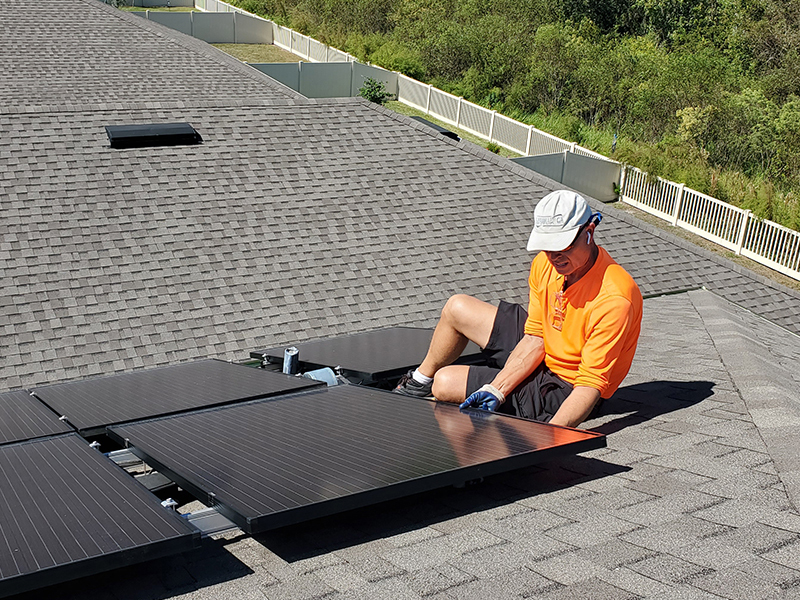This scenario assumes that you have some money saved.
Maximizing Solar Tax Credits through IRA Conversion in Florida
For those considering solar panel installation, an interesting financial strategy involving IRA conversion has emerged. This approach, recommended by some accountants, involves converting a traditional IRA and 401k to a Roth IRA, paying taxes on the conversion, and then utilizing those taxes to claim solar installation tax credits.
Understanding IRA Conversion
An IRA conversion involves shifting funds from a traditional IRA or 401k to a Roth IRA. This process triggers a tax event since traditional IRAs are tax-deferred accounts, while Roth IRAs are funded with after-tax dollars. The conversion increases your taxable income for the year of the conversion. The Balance provides a comprehensive guide on how this conversion impacts your taxes.

Call: (813) 575-3200
Call Us Today To Schedule Your Free Consultation!
Solar Tax Credits and IRA Withdrawal
Solar tax credits can significantly offset the cost of installing solar panels. According to Intuit, residential energy credits can be applied to reduce your income taxes resulting from an IRA distribution. This means the tax liability incurred from the IRA conversion can potentially be offset by the solar tax credit.
Executing the Strategy in Florida
- Consult a Financial Advisor: Before proceeding, consult with a financial advisor or tax professional. They can provide personalized advice based on your financial situation.
- Evaluate Solar Panel Costs: Research the cost of solar panel installation in Florida. Get quotes from multiple vendors to understand the total investment required.
- Understand the Tax Credit: In Florida, the solar investment tax credit allows homeowners to deduct a significant percentage of their solar installation costs from their federal taxes. The exact percentage can vary, so it’s important to stay updated with the latest information.
- Plan the IRA Conversion: Work with your financial advisor to plan the conversion of your traditional IRA or 401k to a Roth IRA. Calculate the tax implications and ensure it aligns with the cost of your solar installation.
- File the Necessary Tax Forms: When filing your taxes, use IRS Form 5695 to claim the solar tax credit. Ensure that the tax credit is applied against the tax liability from your IRA conversion.
- Monitor Adjusted Gross Income: Be aware that a Roth IRA conversion can increase your adjusted gross income, which might affect other tax considerations.

Converting a traditional IRA to a Roth IRA to leverage solar tax credits is a strategic approach that can be beneficial for Florida residents looking to install solar panels. However, it’s crucial to understand the tax implications and consult with a financial advisor to ensure this strategy aligns with your overall financial goals.
The decision to convert a traditional IRA to a Roth IRA and its interaction with solar tax credits is a complex financial matter that hinges on several factors, including your current tax bracket, expected future income, and the specifics of the solar tax credit. Here’s a general overview of how these elements might interact:
- Roth Conversion and Taxable Income: When you convert funds from a traditional IRA to a Roth IRA, the amount converted is added to your taxable income for that year. This could potentially push you into a higher tax bracket, depending on the amount converted and your other income.
- Solar Tax Credits: The solar tax credit, known as the Investment Tax Credit (ITC), allows you to deduct a percentage of the cost of installing a solar energy system from your federal taxes. The ITC is a non-refundable tax credit, meaning it only offsets taxes you owe. If the credit is more than your tax liability in the year you install the system, the excess amount can usually be carried forward to future tax years (subject to the specific rules and time limits of the ITC).
- Interaction Between Roth Conversion and Solar Tax Credits: If you convert a large sum from a traditional IRA to a Roth IRA in the same year you install solar panels, the increased taxable income from the conversion could potentially increase your tax liability. This higher liability might allow you to take fuller advantage of the solar tax credit, as you would have more tax against which to apply the credit.
- Considerations:
- Tax Bracket: Be aware of the potential for the conversion to push you into a higher tax bracket, which could increase your overall tax rate.
- Future Tax Rates: Consider whether you expect your tax rate to be higher or lower in the future, as this affects the benefit of converting to a Roth IRA.
- Solar Tax Credit Limitations: Understand the specifics of the solar tax credit, including how much of the credit you can apply in the first year and how much can be carried forward.
- Financial Planning: Consider your overall financial situation, including cash flow needs and the timing of IRA withdrawals.
- Professional Advice: Given the complexity and the individual nature of tax and retirement planning, it’s highly advisable to consult with a tax professional or financial advisor. They can provide personalized advice based on your specific financial situation, tax implications, and the details of the solar tax credit.
While converting to a Roth IRA in the same year as installing solar panels could potentially allow you to utilize more of the solar tax credit due to an increased tax liability, carefully consider the broader financial implications.
Professional advice is key in navigating these decisions.

Call Us Today To Schedule Your Free Consultation!

